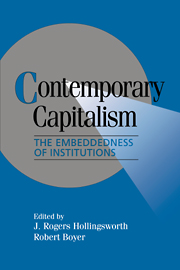Book contents
- Frontmatter
- Contents
- Acknowledgments
- List of Contributors
- Chapter 1 Coordination of Economic Actors and Social Systems of Production
- PART I THE VARIETY OF INSTITUTIONAL ARRANGEMENTS AND THEIR COMPLEMENTARITY IN MODERN ECONOMIES
- Chapter 2 The Variety and Unequal Performance of Really Existing Markets: Farewell to Doctor Pangloss?
- Chapter 3 A Typology of Interorganizational Relationships and Networks
- Chapter 4 Associational Governance in a Globalizing Era: Weathering the Storm
- Chapter 5 Constitutional Orders: Trust Building and Response to Change
- PART II HOW AND WHY DO SOCIAL SYSTEMS OF PRODUCTION CHANGE?
- PART III LEVELS OF SPATIAL COORDINATION AND THE EMBEDDEDNESS OF INSTITUTIONS
- PART IV CONCLUSION
- Index
Chapter 2 - The Variety and Unequal Performance of Really Existing Markets: Farewell to Doctor Pangloss?
Published online by Cambridge University Press: 05 June 2012
- Frontmatter
- Contents
- Acknowledgments
- List of Contributors
- Chapter 1 Coordination of Economic Actors and Social Systems of Production
- PART I THE VARIETY OF INSTITUTIONAL ARRANGEMENTS AND THEIR COMPLEMENTARITY IN MODERN ECONOMIES
- Chapter 2 The Variety and Unequal Performance of Really Existing Markets: Farewell to Doctor Pangloss?
- Chapter 3 A Typology of Interorganizational Relationships and Networks
- Chapter 4 Associational Governance in a Globalizing Era: Weathering the Storm
- Chapter 5 Constitutional Orders: Trust Building and Response to Change
- PART II HOW AND WHY DO SOCIAL SYSTEMS OF PRODUCTION CHANGE?
- PART III LEVELS OF SPATIAL COORDINATION AND THE EMBEDDEDNESS OF INSTITUTIONS
- PART IV CONCLUSION
- Index
Summary
A RETURN TO FREE MARKET CONCEPTIONS: WHY?
The conceptions about the self-regulating mechanisms associated with markets have undergone the equivalent of a long wave. During the Great Depression of the 1930s, a majority of economists were critical of the institutional impediments to the free functioning of markets. Only a minority argued that it was in the very nature of free markets to trigger large instabilities and/or stagnation (Weir and Skocpol, 1985). After World War II, the Keynesian heterodoxy became the core of significant revolution concerning the respective roles that the state and market should play in the long run social and economic reproduction of capitalism: Adequate public regulation and fine tuning of monetary and fiscal policies could promote quasifull employment, along a steady growth path. Basically market mechanisms had to be tamed by a series of legislation, regulation, and collective agreements, as well as built-in stabilizers in the tax system and/or in the reaction functions of central banks. As Joan Robinson recurrently pointed out, markets were efficient for allocating scarce resources between alternative goals via the formation of relative prices. But one major drawback resulted from the fact that pure market mechanisms were generally unable to provide full employment and macroeconomic stability. In fact during the fifties and sixties this view was widely shared by almost all governments, including the most conservative ones. Did not Richard Nixon declare, “Now we are all Keynesians”?
- Type
- Chapter
- Information
- Contemporary CapitalismThe Embeddedness of Institutions, pp. 55 - 93Publisher: Cambridge University PressPrint publication year: 1997
- 29
- Cited by



